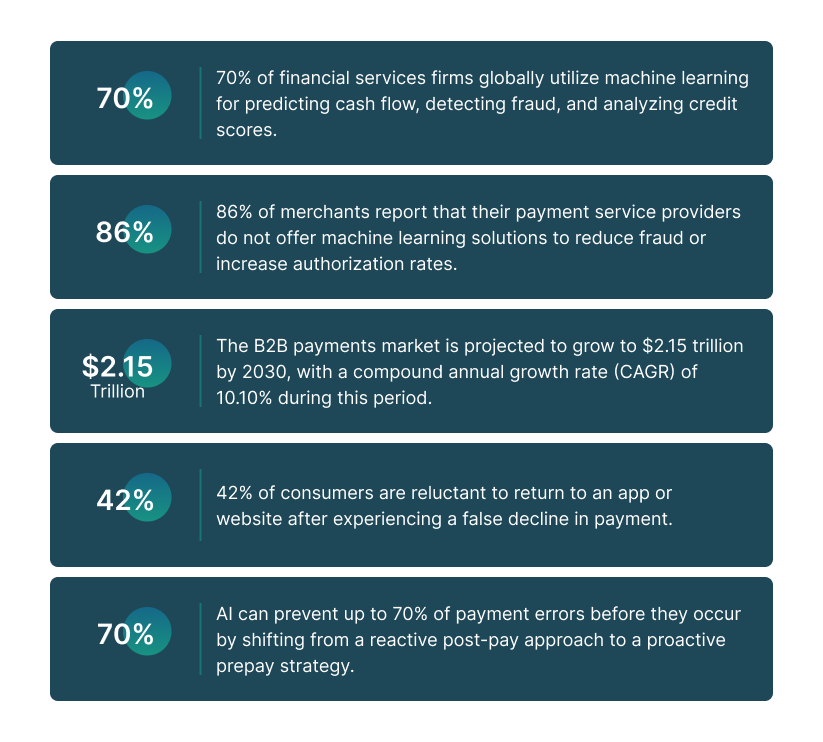AI Payment Reconciliaition
Avoiding Costly Payment Errors: How AI Drives Data Transparency
Discover how AI-driven solutions enhance data transparency to prevent costly payment errors, streamline operations, and build trust in financial processes.

Amrit Mohanty
Dec 24, 2024 (Last Updated: Nov 11, 2025)

Even a minor payment error in today's financial climate can create an amount of loss so high that it can cripple business, damage relations, and even attract a fine. The most common forms of payment errors include incorrect fund allocation, repeated payments, or missed due dates.
A Trustmi survey of 516 organizations revealed that 50% experienced payment fraud due to human error, with 41% automating some workflows but 27% still relying on manual processes. Despite available fraud prevention tools, 14% of organizations remain unprotected, leaving their payments vulnerable.
Since companies are looking for increased efficiency and accuracy, AI-powered solutions have emerged as revolutionary solutions that can proactively allow firms to achieve data transparency while minimizing costly mistakes, ultimately helping ensure precision in payment processes.

Here’s how artificial intelligence (AI) is reshaping payment ecosystems, helping businesses avoid costly mistakes while enabling a streamlined, transparent approach to managing financial operations.
The True Cost of Payment Errors
Mistakes in payment processing can lead to significant consequences for businesses, impacting not only their finances but also their reputation and operational efficiency. Here are key insights into the true costs of payment errors, supported by relevant data points.
1.Damaged Trust
- Customer Confidence: A survey indicated that 49% of businesses reported that broken or failed payments severely impacted their operational costs. This loss of trust can lead to decreased customer loyalty and potential loss of future business.
- Vendor Relationships: Timely payments are crucial. Late payments can damage relationships with vendors, leading to a 64% impact on staff due to the time spent resolving disputes related to payment failures.
2.Operational Bottlenecks
- Time Wasted: Businesses face operational inefficiencies as teams spend time addressing payment disputes rather than focusing on growth strategies. The average cost of processing an invoice manually is approximately $15, and nearly 40% of invoices contain errors, which can lead to delays and additional costs.
- Error Rates: The average global straight-through processing (STP) rate is only 26%, indicating that many transactions require manual intervention due to errors, further complicating operational efficiency.
3.Financial Penalties
- Cost of Errors: Errors in payment processes will also lead to significant penalties. For instance, corporations experiencing a high failure rate on their transactions often incur millions of dollars in losses, as well as the indirect cost impacts on productivity and customers' satisfaction.
- Compliance Risks: Non-compliance with payment terms can lead to heavy fines. Organisations often face legal repercussions due to failure to meet contractual obligations arising from problems related to payment processing.
AI-Powered Precision in Payment Reconciliation
Payment reconciliation is one of the most critical but mundane processes for financial institutions and businesses, dealing with a vast volume of data from sources including bank statements, invoices, and internal systems. As human operators are involved, manual methods are bound to make errors because humans miss discrepancies or fail to spot patterns that indicate a potential problem.
This process was turned around by the AI technology with real-time transactional and analytical monitoring. For example, using historical data and ensuring appropriate decisions on which transaction is approved, a decrease of up to 50% in transaction decliners will be achieved on a transaction decline by utilizing systems that are AI-automated, such as Visa's Smarter Stand-in Processing (STIP).
However, a lot of businesses still use the manual approach which is prone to errors, as human operators can overlook discrepancies or fail to spot patterns indicating potential issues.
AI takes this burden off human shoulders by offering unparalleled precision:
1. Real-time Reconciliation
This technology is increasing adoption across industries, fueling massive growth in the reconciliation software market worldwide. With a value of $1.75 billion in 2023, the market size is expected to grow up to $2.01 billion in 2024 and to an astonishing $6.44 billion in 2032. The purpose of real-time reconciliation is to allow AI to be able to constantly keep track of and reconcile transactions as they happen. It would enable banks and financial institutions to access financial data instantaneously, thus improving decision-making and optimizing cash flow management.
2. Pattern Recognition
According to the Institute of Finance and Management, organizations lose an average of 0.05% to 0.1% of their total expenditures because of duplicate payments. The percentage may seem small, but it can lead to significant losses for large companies with high volumes of accounts payable. Machine learning models are excellent for catching repetitive problems, for example, double payments or differences between the account balances/ These anticipatory measures not only save money but also develop confidence in financial reporting.
3. Automated Resolution Suggestions
AI-powered solutions will continue revolutionizing payment reconciliation, increasing accuracy and automating suggestion resolution. With the ability to process large volumes of transaction data, AI can match transactions with over 99% accuracy, thereby reducing reconciliation time by a significant margin. In fact, some organizations have reported up to an 80% reduction in reconciliation times due to AI implementation, allowing finance teams to focus on more strategic tasks rather than manual data entry and error correction.
Imagine a fintech operation in which every single transaction is validated, in real-time discrepancies are fixed, and financial teams make more strategic decisions than fix errors. That's the promise of AI-powered payment reconciliation.
The Foundation of AI Success: Data Preparation
For AI to become what everyone claims to be, then its quality of input data must be top-notch. The foundation of every AI-powered payment system is data preparation. Incomplete or poorly organized data leads to inaccurate insights and reduces the operational efficacy of AI algorithms. Let;s explore more on this!
Here’s how fintech companies can ace data preparation:
By investing in meticulous data preparation, businesses can unlock the full potential of AI, ensuring that their payment processes are not only transparent but also error-free.
Revolutionizing Fintech Operations with AI
The adoption of AI in fintech operations goes beyond reconciliation; it’s redefining how financial ecosystems function. Here's how an AI-powered environment transforms fintech operations:
- Enhanced Fraud Detection: AI technologies can reduce fraudulent transactions by up to 40% when integrated with existing fraud prevention measures. It can monitor transaction patterns and detect irregular activities, such as unauthorized access or unusual spending behavior, reducing the risk of fraud.
- Optimized Cash Flow Management: AI helps businesses predict cash flow trends by analyzing historical data and external factors, such as market conditions, enabling better financial planning. In fact, companies using AI-driven cash forecasting models saw a 66% rise in bank transactions processed for forecasting in 2023-2024.
- Personalized Customer Experience: AI-driven chatbots and tools offer personalized solutions for customers, such as resolving payment issues or suggesting financial products tailored to their needs. 42% of customer service pros using AI say chatbots that respond to requests are very effective.
- Compliance Automation: With ever-evolving regulations, compliance can be a nightmare. AI simplifies the process by automatically analyzing compliance requirements and ensuring all transactions adhere to legal standards. According to a Drata report, 40% of teams continually review compliance controls with automation.
Fintech companies operating in an AI-powered environment can stay agile, reduce operational costs, and deliver superior value to their stakeholders.
Why Data Transparency is the Ultimate Goal
Transparency is critical in payment operations. When all stakeholders—finance teams, vendors, and customers—have a clear view of payment data, errors are less likely to occur, and trust grows.
AI-driven tools foster transparency by:
- Providing Real-time Dashboards: Finance teams can track every transaction in real-time, ensuring complete visibility.
- Generating Detailed Reports: Comprehensive reports highlight discrepancies and provide a clear audit trail, making compliance and accountability seamless.
- Enabling Predictive Analytics: AI can anticipate potential issues, offering insights into trends that could lead to errors if left unchecked.
Looking Ahead: The Future of Payments in an AI-Driven World
AI is no longer a future concept but rather something businesses must have if they are to succeed in the new financial ecosystem. Using AI-driven solutions can eliminate costly errors, improve operational efficiency, and help organizations build trust through data transparency.
If your business is riddled with payment errors, now is the time to embrace AI and transform your operations. With tools designed to reconcile payments, prepare data, and optimize workflows, the future of payments is transparent, efficient, and error-free.

